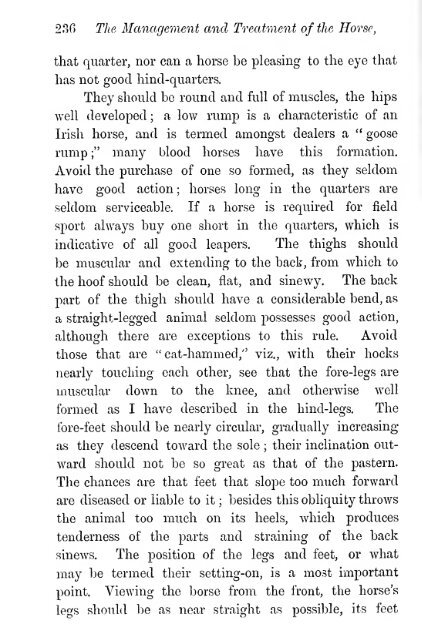The management and treatment of the horse in the stable, field, and ...
The management and treatment of the horse in the stable, field, and ...
The management and treatment of the horse in the stable, field, and ...
Create successful ePaper yourself
Turn your PDF publications into a flip-book with our unique Google optimized e-Paper software.
2:16 <strong>The</strong> Management <strong>and</strong> Treatment <strong>of</strong> <strong>the</strong> Horse,<br />
that quarter, nor can a <strong>horse</strong> be pleas<strong>in</strong>g to <strong>the</strong> eye that<br />
has not good h<strong>in</strong>d-quarters.<br />
<strong>The</strong>y should be round <strong>and</strong> full <strong>of</strong> muscles, <strong>the</strong> hips<br />
well developed ; a low rump is a characteristic <strong>of</strong> an<br />
Irish <strong>horse</strong>, <strong>and</strong> is termed amongst dealers a " goose<br />
rump ;" many blood <strong>horse</strong>s have this formation.<br />
Avoid <strong>the</strong> purchase <strong>of</strong> one so formed, as <strong>the</strong>y seldom<br />
have good action; <strong>horse</strong>s long <strong>in</strong> <strong>the</strong> quarters are<br />
seldom serviceable. If a <strong>horse</strong> is required for <strong>field</strong><br />
sport always buy one short <strong>in</strong> <strong>the</strong> quarters, which is<br />
<strong>in</strong>dicative <strong>of</strong> all good leapers. <strong>The</strong> thighs should<br />
be muscular <strong>and</strong> extend<strong>in</strong>g to <strong>the</strong> back, from which to<br />
<strong>the</strong> ho<strong>of</strong> should be clean, flat, <strong>and</strong> s<strong>in</strong>ewy. <strong>The</strong> back<br />
part <strong>of</strong> <strong>the</strong> thigh should have a considerable bend, as<br />
a straight-legged animal seldom possesses good action,<br />
although <strong>the</strong>re are exceptions to this rule. Avoid<br />
those that are "cat-hammed," viz., with <strong>the</strong>ir hocks<br />
nearly touch<strong>in</strong>g each o<strong>the</strong>r, see that <strong>the</strong> fore-legs are<br />
muscular down to <strong>the</strong> knee, <strong>and</strong> o<strong>the</strong>rwise well<br />
formed as I have described <strong>in</strong> <strong>the</strong> h<strong>in</strong>d-legs. <strong>The</strong><br />
fore-feet should be nearly circular, gradually <strong>in</strong>creas<strong>in</strong>g<br />
as <strong>the</strong>y descend toward <strong>the</strong> sole ; <strong>the</strong>ir <strong>in</strong>cl<strong>in</strong>ation out-<br />
ward should not be so great as that <strong>of</strong> <strong>the</strong> pastern.<br />
<strong>The</strong> chances are that feet that slope too much forward<br />
are diseased or liable to it ; besides this obliquity throws<br />
<strong>the</strong> animal too much on its heels, which produces<br />
tenderness <strong>of</strong> <strong>the</strong> parts <strong>and</strong> stra<strong>in</strong><strong>in</strong>g <strong>of</strong> <strong>the</strong> back<br />
s<strong>in</strong>ews. <strong>The</strong> position <strong>of</strong> <strong>the</strong> legs <strong>and</strong> feet, or what<br />
may be termed <strong>the</strong>ir sett<strong>in</strong>g-on, is a most important<br />
po<strong>in</strong>t. View<strong>in</strong>g <strong>the</strong> borse from <strong>the</strong> front, <strong>the</strong> <strong>horse</strong>'s<br />
legs should be as near straight as possible, its feet
















